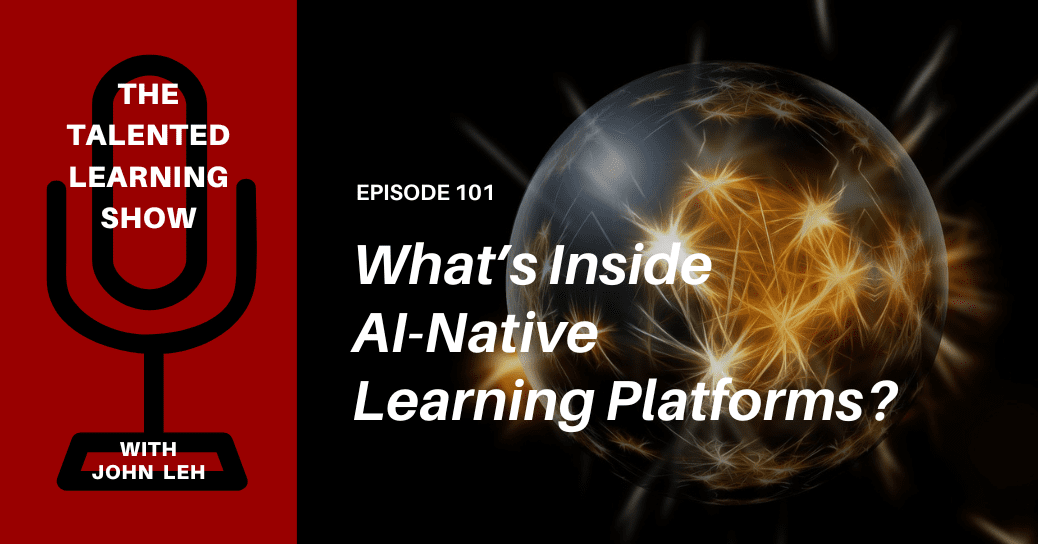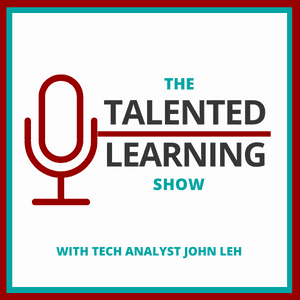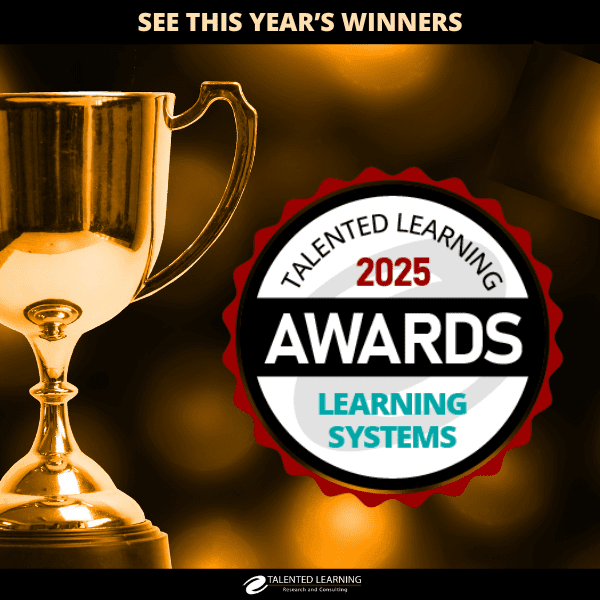
Podcast: Play in new window | Download
Subscribe: Apple Podcasts | Spotify | Amazon Music | Android | Blubrry | Youtube Music | RSS
EPISODE 101: AI-Native Learning Platforms
If you’re following the AI action in enterprise learning, you probably feel bombarded by buzz. It’s tempting to dismiss everything as hype. But can you afford to overlook solutions that are truly transforming the industry?
As an LMS consultant, this is where the challenge begins for me. In a sea of possibilities, I want to shine a light on what actually works.
Case in point: AI-native learning platforms are already making their mark. That’s why I’m discussing them today with Josh Bersin, Founder and CEO of The Josh Bersin Company.
Josh is arguably the world’s foremost HR and learning technology authority. Recently, his team introduced a powerful AI-native learning solution for professionals who want real-time access to highly personalized, authoritative HR advice and insights. And the early reviews are glowing.
So, join us as we talk about why AI-native learning systems are such an important breakthrough. What should you expect from these capabilities? And how will they shape the future of enterprise learning? Find out as we dig deeper on this episode of the Talented Learning Show…
AI-NATIVE LEARNING PLATFORMS – KEY TAKEAWAYS
- Agentic AI is giving rise to a new breed of learning system — the AI-native learning platform. It includes many LMS features, but behaves in a more proactive, intelligent way. Unlike tools that run on top of an LMS, AI-native learning platforms are more deeply integrated into an organization’s broader tech ecosystem. This makes them attractive LMS replacements.
- AI-native learning platforms can continuously pinpoint skill gaps and other learning needs among individuals, teams, or across an organization. Then, they dynamically deliver relevant content, coaching, or other support that drives measurable improvement.
- These platforms have far-reaching implications. Not only are they transforming the way organizations build and deliver instructional content, but they’re also helping learning leaders add value as strategic business partners.
AI-NATIVE LEARNING PLATFORMS – Q&A HIGHLIGHTS
Welcome, Josh. For those few listeners who may not be familiar with you, could you introduce yourself and your organization?
Sure. I have been a research analyst and advisor in HR, learning, and technology related to those topics for almost 30 years. Our company provides advisory services to vendors. Also, we offer corporate memberships, and we have an AI agent called Galileo that delivers a lot of this.
You probably publish more research than anybody in the HR space. Tell us about your latest report…
The project we probably want to discuss here is The Revolution in Corporate Learning. The report is not very long, but it is very profound in its implications.
I’ve been doing work in L&D for many years. Our original research in this space was The High-Impact Learning Organization, focused on the structure of L&D in the early days of elearning.
But over the past two decades, I’ve observed a sort of demotion of L&D. This once very senior, strategic C-level role has been diminished. We see heads of training, content, and LMS administration, while many high-value parts of L&D have been distributed throughout the business.
Find out how real-world companies are achieving more with learning systems that create business value. Get inspiration from dozens of success stories in our free LMS Case Study Directory →
To understand this shift, we did a study over the last two years. And we discovered L&D is a $350-400 billion space. It is very, very big.
It doesn’t belong entirely in HR, but it got stuck there.
And now, L&D is being completely transformed by AI. Very soon, it will be much, much different. This shift is at least as big as the elearning era of 2000-2001. That’s why we decided to call this a revolution.
I’m writing an article about the AI applications I’ve seen this year, and that list has already ballooned to 16 or 17 use cases. How do AI-native learning platforms address this?
Well, it’s not just small use cases. I mean, it’s a natural reaction for L&D to say, “Let’s use AI to create a chatbot or to build courses or graphics or simulations.”
It’s all of that, plus something even bigger, which is the shattering of the publishing paradigm of learning.
Mmhmm…
For 25 years, the paradigm of learning has been the pedagogical structure of training and education. A teacher collects information and creates a lesson guide, a course, or a structured set of activities. Then, a learner consumes what the educator created for you.
You have interactive experiences with the educator, the course, and your peers. And afterwards, you are supposed to have learned something.
That paradigm is very useful in the academic world. But at work, it breaks down. So, for years, we tried learning in the flow of work, LXPs, virtual reality, and a hundred other things.
But the fundamental paradigm of somebody building something for you to consume is going to be shattered by AI. That’s because AI builds it automatically based on what you want and need to learn at the moment.
Don’t miss what’s happening at the leading edge of enterprise learning technology! Get our weekly email brief. SUBSCRIBE HERE →
With AI-native learning platforms, you can ask a question, or browse a course, or talk to an AI tutor, or whatever you need. The system knows who you are and learns about your level of capability from your experience with the system.
And by the way, the system builds its own skills taxonomy. So, you don’t have to do a manual skills taxonomy. All of these manual publishing processes start to go away with an AI-native learning platform. It is not just a learning platform, but a dynamic enablement platform.
I see…
As a result, the L&D function is different. We don’t need a hundred content developers. We might need some, but a much smaller number.
Now, dynamically, we can quickly build content in multiple languages. We don’t have to go back and edit, replace, and update old courses. We don’t have to buy giant course libraries and deal with subscription fees for multiple vendors who may not have updated their content in months or years.
It is very, very different.
Right…
Also, with an AI-native learning platform, the organization has near real-time information about workforce learning needs, performance needs, or skills needs. Because you can see what people are asking for, doing, and demanding.
This means the L&D function can focus on the most urgent day-to-day business needs local to each area.
Also, this process doesn’t need to be centralized. Say I’m in sales enablement and we have a new price list and product documentation. Or I’m in a manufacturing plant where we need to publish new safety rules.
I load it into the system, and immediately, the right people get access to up-to-date information that is most relevant for their local needs. So, the corporate team may not need to be involved in this at all if it’s not relevant to other parts of the company.
How long do you think the L&D transition to AI-native learning will take, Josh?
The problem is that many people are using AI to automate the old way of doing things. But the paradigm needs to shift.
For example, I recently saw an ATD course on using AI for instructional design to build courseware. But that’s the wrong idea. Maybe we’ll never need courseware. We may not even call this content “courses.”
At Bersin, we have an online HR academy that’s about 8 years old. We had a lot of courses, content, curriculum, resources, videos, and more. In 5 months, we reconverted that to an AI system we call Galileo Learn.
We now have 750 independent learning objects that can be assembled dynamically, based on an individual’s needs. In the old paradigm, each of those combinations might have been considered a small course.
Which learning system is right for you? Check our RightFit Solution Grid, based on our team’s independent research! Learn more and get your free copy →
When someone starts interacting with these modules, an AI agent is sitting on the side. So, let’s say you want to find out about employee experience or diversity or hiring, or HR tech. The agent uses available content to answer your questions immediately. And when you finish a module, the system challenges you and literally coaches you.
Cool…
And this is available now.
But here’s the problem. Everybody already has an LMS, and LMS vendors can’t build this because it is not an LMS.
An AI-native learning platform is a dynamic content system, separate from an LMS. And it may not be possible for LMS vendors to build it without starting over or investing heavily in R&D.
Makes sense…
So, I think AI-native learning platforms will significantly change the market. Today, there are only a handful of companies that are building truly dynamic AI-native learning solutions from the ground up.
Traditional LMS vendors are working on this and trying to figure out what to do. But it’s a new world for them. Because these are AI platforms. They need AI infrastructure — vector databases, RAG. All the technology from the agent world will need to come to L&D.
Good point. Let’s come back to that. But first, how did you transform all your content into 750 objects in only 5 months? That’s impressive…
We work with a platform company called Sana. It’s a very cool Swedish company that has been helping us for 3 years.
The primary process includes building templates, colors, fonts, and structured formats. Then, you literally load the old content and regenerate it into new content.
There is virtually no need for meticulous page-by-page graphic design. But you have to build templates upfront. And most instructional design people or savvy web developers can easily do this.
Also, we had a skills framework. But if you don’t have a capability model, an AI-native learning platform will generate one for you. That’s because it knows every word of every video and every piece of content in the corpus.
So, it will tell you what the topics or skills are. Then you can decide which ones you want to use.
Wow…
Also, this blows my mind. As people start interacting with content, the system assesses their level of capability for each skill — from beginner, to intermediate, to advanced — based on questions they ask and content they consume over time.
That’s how it starts becoming your personal tutor. And over time, we expect these systems to become much more agentic in nature.
So, rather than having to log in to a portal and browse around to find the content you need, you could simply ask your agent a question. It would respond not only with the answer to your question, but also with related course materials you may want to consume next.
That’s how our platform works. The Galileo AI Assistant accesses Galileo Learn.
Buying or selling a customer-focused learning system? Get independent insights you can trust, with our in-depth analysis of 16 top solutions. Learn about our Customer LMS Buyer’s Guide →
Interesting. So, Galileo is partly an outward-facing university, serving other organizations’ employees. What kind of companies are using this internally?
Right now, we’re working with a major insurance company that is basically moving all their training on claims processes, customer interactions, and business processes into Galileo Learn. But they’re planning to keep their regulatory compliance in their traditional LMS.
We’re doing the same thing with a pharmaceutical company.
Also, we’re in the middle of a big project with a defense contractor that is using Galileo AI to roll out a new mandated leadership program in 60 days. And next, they’re planning to use it for all their new leadership programs.
So, this is happening in the real world. It is liberating L&D departments to move faster and get closer to the business, rather than getting bogged down in lengthy content publishing projects where results are hard to measure.
For sure. You mentioned that L&D has lost its seat at the executive table. Can AI-native learning platforms help the corporate learning function restore its worth?
Absolutely. We interviewed 40 CLOs for our research, and they are desperate to be more relevant to their companies.
Suddenly, AI-native learning gets these people deeply involved in solving massive business problems they couldn’t address quickly before. I know they have the energy, experience, and desire for this. So, as they get their hands on AI-native learning platforms, they’ll add value on a day-to-day basis.
No doubt…
Keep in mind that most companies are rolling out broader AI strategies with employee agents for multiple purposes. And AI-native learning platforms can plug into that.
You don’t need to start from scratch or create a separate little island of new technology. Instead, you can be part of an overall corporate AI strategy by delivering enablement and learning with whatever tools the rest of the company is already adopting.
So, the timing is perfect for learning teams to get involved with strategic business initiatives.
In addition to Sana, which companies are leading the way with AI-first learning solutions? …
… For complete answers to this and more questions about AI-native learning, listen to the full episode on Apple Podcasts, on Spotify, on Amazon, or right here on our site.
Watch This Podcast on YouTube
See AI-Native Learning in Action
For a live example of AI-native learning, visit Bersin’s Galileo AI website →
Also, to get a copy of The Revolution in Corporate Learning research report, visit the Bersin Company Website →
Find Out More About the Sana AI-Native Learning Platform
Check my Hot Take Review of Sana on YouTube:
Is AI-Native Learning Right for You? Let’s Talk
Interested in AI-native learning, but not sure where to look? For fiercely independent advice you can trust, schedule a free 30-minute consult below with me, John Leh…
*NOTE TO SALESPEOPLE: Want to sell us something? Please contact us via standard channels. Thanks!











